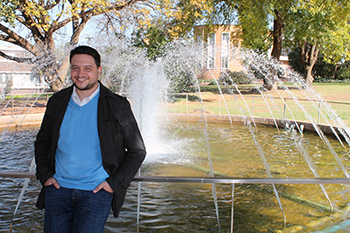
André Janse van Rensburg, researcher at the
Centre for Health Systems Research and Development
at the University of the Free State, will be spending
almost three weeks in Vancouver, Canada. He will be
attending the Emerging Voices for Global Health programme
and Global Symposium on Health Systems Research.
Photo: Jóhann Thormählen
His research on the implementation of the Integrated School Health Programme (ISHP) in rural South Africa led to André Janse van Rensburg being selected to become part of the Emerging Voices for Global Health (EV4GH) group.
It is a collection of young, promising health policy and systems researchers, decision-makers and other health system professionals. A total of 222 applications from 50 countries were received for this programme, from 3-19 November 2016 in Vancouver, Canada.
The EV4GH is linked to the fourth Global Symposium on Health Systems Research (HSR2016), from 14-18 November 2016. It also taking place in Vancouver and Janse van Rensburg will be taking part, thanks to his research on the ISHP in the Maluti-a-Phofung area. He is a researcher at the Centre for Health Systems Research & Development (CHSR&D) at the University of the Free State (UFS).
The theme of the HSR2016 is Resilient and Responsive Health Systems for a Changing World. It is organised every two years by Health Systems Global to bring together roleplayers involved in health systems and policy research and practice.
Janse van Rensburg also part of Health Systems Global network
The EV4GH goals relate to the strengthening of global health systems and policies, particularly from the Global South (low-to-middle income countries with chronic health system challenges). The initiative involves workshops, presentations, and interactive discussions related to global health problems and solutions.
As an EV4GH alumni, Janse van Rensburg will become part of the Health Systems Global network. Partnering institutions include public health institutes from China, India, South Africa, Belgium, and the UK.
“The EV4GH is for young, promising health
policy and systems researchers, decision-makers
and other health system professionals.”
Research aims to explore implementation of schools health programme
In 2012, the ISHP was introduced in South Africa. This policy forms part of the government's Primary Health Care Re-engineering Programme and is designed to offer a comprehensive and integrated package of health services to all pupils across all educational phases.
Janse van Rensburg, along with Dr Asta Rau, Director of the CHSR&D, aimed to explore and describe implementation of the ISHP. The goals were to assess the capacity and resources available for implementation, identify barriers that hamper implementation, detect enabling factors and successful aspects of implementation and disseminate best practices in, and barriers to, ISPH implementation with recommendations to policymakers, managers and practitioners.
“A lot of people were saying they don’t
have enough resources to adequately
implement the policy as it is supposed to
be implemented.”
Findings of project in Maluti-a-Phofung area
Janse van Rensburg said the ISHP had various strengths. “People were impressed with the integrated nature of the policy and the way people collaborated across disciplines and departments. The school team were found to work very well with the schools and gel well with the educators and principles.”
He said the main weakness of the implementation was resources. “A lot of people were saying they don’t have enough resources to adequately implement the policy as it is supposed to be implemented.
“Another drawback is the referral, because once you identify a problem with a child, the child needs to be referred to a hospital or clinic.” He means once a child gets referred, there is no way of knowing whether the child has been helped and in many cases there is no specialist at the hospital.